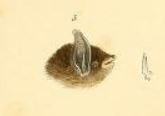Silver-tipped myotis facts for kids
Quick facts for kids Silver-tipped myotis |
|
|---|---|
 |
|
| Conservation status | |
| Scientific classification | |
 |
|
| Silver-tipped Myotis Bat range |
The silver-tipped myotis (Myotis albescens) is a small bat. It is known for its unique "frosted" fur. This bat lives in many different lowland areas across the Americas.
It belongs to a large group of bats called Myotis. These bats are also known as vesper bats. Scientists have studied its genes. They think it might be related to other Myotis species found in warm parts of America.
Contents
What Does the Silver-tipped Myotis Look Like?
The silver-tipped myotis is a small bat. It measures about 7.9 to 9.6 centimeters (about 3 to 3.8 inches) long. Its tail is about 2.7 to 4.0 centimeters (about 1 to 1.6 inches) long.
Its fur is long and very soft. Each hair is dark at the bottom. But the very tip of each hair is white. This white tip makes the bat look "frosted" or "silver-tipped." This special fur pattern helps tell it apart from other similar bats.
The bat's belly and legs are lighter in color. Its wings are bare skin. They can be light brown or almost black. This bat has a round head and pointy ears. Its feet are quite large. The skin membranes of its wings attach to its toes. There is also a membrane between its legs. A long bone called a calcar helps support this membrane. It even sticks out a little past the edge.
Where Do Silver-tipped Myotis Bats Live?
The silver-tipped myotis is one of the most common bats in its group. You can find it in almost every country in South America. It lives in places like Panama, Costa Rica, and Mexico.
These bats can live in many different lowland areas. This includes forests, bushy areas, and wet open lands. They also live in pastures. They usually stay below 500 meters (about 1,640 feet) above sea level. They are often found near open water. You won't find them in cold places like the Andes mountains.
How Do Silver-tipped Myotis Bats Behave?
Like most bats, silver-tipped myotises are active at night. They are busiest right after the sun sets and before it rises. During the day, they rest in small groups. They find holes in trees or cracks in cliffs to sleep. They prefer places near water.
These bats do not usually live in caves. They like more open spots with some fresh air and light. In towns, they might roost under roofs or in attics. They don't truly hibernate in winter. But they might slow down if a night gets very cold.
They eat insects like beetles, flies, and lepidopterans (moths and butterflies). They also eat spiders. These bats fly slowly. They fly low to the ground or over water. They use their big feet to catch insects. When hunting, they make short, high-pitched calls. These calls help them find their prey in the dark.
Reproduction and Life Cycle
Male and female silver-tipped myotises often roost together. There isn't a specific time of year for them to have babies. Females usually have two or three babies each year.
A mother bat is pregnant for about three months. She then gives birth to one baby bat. The baby bats drink their mother's milk. They are ready to stop drinking milk at about one month old. By this time, all their adult teeth have grown in.
See also
 In Spanish: Murciélago vespertino plateado para niños
In Spanish: Murciélago vespertino plateado para niños


